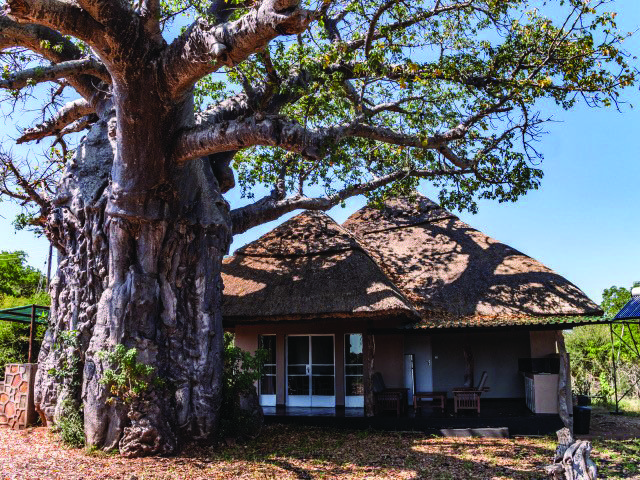A Place of Elephants by Sarah Todd
Covering an area of more than 5,000 square kilometres, Gonarezhou National Park, located in the south east of Zimbabwe, is our country’s second largest national park. Together with Mozambique’s Limpopo National Park and South Africa’s Kruger National Park Gonarezhou comprises one third of Southern Africa’s Great Limpopo Transfrontier Park.
The name Gonarezhou means “Place of Many Elephants” and the park can comfortably contain 8,000 of these animals. Currently the elephant population in Gonarezhou is around 12,000 animals, but there are currently no plans to reduce their numbers- it is hoped some of the population will move into South Africa and Mozambique.
In Gonarezhou time has stood still for more than 50 years, making it the perfect place for anyone wanting to experience wild, untamed and natural Africa. The dirt roads inside the park are in good condition. National Parks’ large square cement and stone blocks contain faded but visible directions.
Gonarezhou’s vegetation is varied and changes quickly; a short drive through Mopane woodland morphs into a baobab tree forest, with ridges and clumps of this most iconic African tree filling the landscape.
Many baobabs have been damaged by elephants gouging out the soft bark to get at the trees’ water reserves. Baobabs are tough trees with the ability to regenerate their bark. They usually recover from the often harsh mutilations inflicted upon them by thirsty elephants. Unfortunately, the additional stress caused by the overpopulation of elephants has caused some of the trees to fall over and die. To try and preserve some of the older trees National Parks have placed rings of stones around their bases to keep the elephants away and give the trees a chance to recover – this seems to be working.
Suddenly the baobabs disappear and are replaced by palm trees and vegetable ivory, a legacy from the 18th and 19th century traders who sailed up the Save River – apparently the rings used to tie their dhows are still visible at Chilo Gorge. We found a small forest of the rare hardwood “panga” trees, reaching up to twenty metres in height.
Close to the confluence of the Save and Runde Rivers the vegetation becomes tropical, thick with huge trees covered in lush green foliage with vines snaking through their massive branches. At 164 metres above sea level this is the lowest point in Zimbabwe, and Mozambique is on the other side of the river.
Chilojo Cliffs is a highlight of a visit to Gonarezhou. We were there at midday, with elephant, impala and baboons for company. The red sandstone cliffs loom above the Runde River, and its colours change depending of the time of day. In the early morning and evening the cliffs have a rich reddish gold hue that enhances the silhouetted baobab trees. During the day colour variations of the white-cream-yellow-ochre- pink-brown spectrum highlight the vertical fissures and horizontal fault lines.During that first day we counted at least twenty six different mammal species. While we didn’t see any big cats we saw spoor and droppings of lion, hyena and wild dog. Antelope sighted include eland, duiker, steenbok, kudu, impala, waterbuck, nyala and sable. Gonarezhou has the largest concentrated variety of bird life in Zimbabwe, with over four hundred different birds identified. We saw eagles, vultures, saddle bill storks, grey herons, doves, bee eaters, an eagle owl, hoopoe, barbets, doves and many others.
Two of the most notable water pans are Tembahata and Machanu, located in eastern Gonarezhou. The abundance of birdlife makes the pans excellent for birders and photographers. Wooden bench tables are perfect for picnics – we cooked and ate a hearty breakfast while watching baboons play and elephants, antelope and hippos enjoying the waters.
National Parks has lodges at Mabalauta, while Chipinda Pools and Swimuwini offer thatched shelter and ablutions. Chinguli, with nine basic camp sites, is perfect for the most rustic bush experience.
Chilo Gorge Lodge, overlooking the Save River, offers a variety of luxurious and affordable accommodation and is located at one of the entrances into Gonarezhou. The self-catering lodges include a family lodge for six guests. All have full en-suite bathrooms, a communal kitchen, dining room and braai area plus a plunge pool. The main lodge is beautifully designed around magnificent gardens and a sparkling pool and dining area, with stunning views over the river. Gonarezhou is harsh and beautiful and nature is at her most powerful in this part of Zimbabwe. Man is the visitor here, not the resident. A trip to Gonarezhou is a chance to experience wild Africa.
- The Gonarezhou National Park was formally created in 1975 by uniting former hunting areas and tsetse fly control corridors.
- Between three and six hundred years ago Arab traders sailed up the Save River into Gonarezhou, exchanging beads, textiles, ceramics and other goods for gold, ivory and possibly slaves.
- In 1992 one of southern Africa’s worst droughts in history saw thousands of animals dying of thirst and starvation. Since then the Park has thrived, and today boasts healthy numbers of many different animal species.
- Rangers in the park claim the reason their elephants are aggressive is because generations of surviving elephants have passed stories of poaching, culling and hunting down to their families.
- Gonarezhou National Park is managed by the Zimbabwe Parks and Wildlife Management Authority with support from the Frankfurt Zoological Society (FZS).
- In 2010 the FZS entered into a ten year management contract with ZimParks, the same year the Greater Limpopo Transfrontier Park was established. Known as a “Peace Park”, the GLTP was established by the Peace Parks Foundation.
- HOW TO GET THERE
- 6 hours drive from Harare WHEN TO GO
- All year round PRICING
- Various accommodation options available from camping to self catering and privately run lodges. Prices vary according to accommodation

